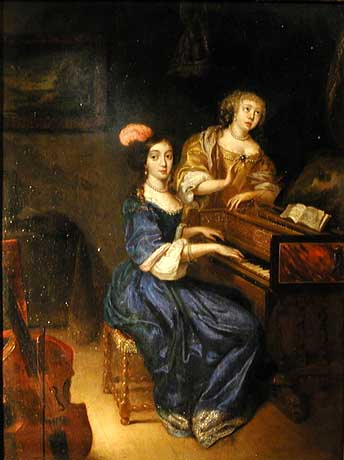Thus spoke Goethe upon hearing a work by Bach. Many listeners today may undergo that same uncanny experience. Viewed historically, it is thanks to the artistic greatness of Johann Sebastian Bach that old music underwent a rebirth during the early 19th Century, which has not abated even today: his music never fell in total oblivion. On the other hand it is because of the prevailing interest in old music that the works of this composer are so frequently heard in church and concert hall. Bach's creations may indeed be considered undisputedly to be the starting point of traditional - i.e. classical and romantic - music; nevertheless, if one wishes to come to grips with Bach, one must understand him to be rather the culmination of a spiritual-philosophical epoch. Only the philosophical thought of this epoch - the Baroque - deciphers for us the inherent values of this art form, a very intellectual one, which is designed to convey to the listener affects and passions of the human essence.
Through the detailed study of the three sonatas for obligato harpsichord and viola da gamba insights may be gained into the compositional methods, the lines of thought and the inner functioning's of this baroque musical language, by which the modern listener may unravel the meanings intertwined in these rhetorical figures familiar to Bach's contemporaries.
Although the extant manuscript sources yield practically no clues as to the exact date of composition, these sonatas were could have been conceived in Coethen, alongside the bulk of his instrumental legacy. At court Bach dedicated himself almost exclusively to the composition of chamber music, after his efforts to create a "proper" church music had been effectively thwarted by the intellectual intolerance and bigotry towards art of the religious authorities - of pronounced pietistic conviction - of his previous church posts. In Coethen a small but outstanding ensemble of musicians stood at Bach's disposal, which could do justice to his demanding compositions. Even his aristocratic master, Prince Leopold, played both harpsichord and viola da gamba passionately: yet another ground to suspect that these sonatas could have come to life in Coethen (although no manuscript sources from this period are known to exist). If Leopold reached for the viol, Bach could readily accompany him on the keyboard; if instead, the prince chose to play the latter, the excellent court violist da gamba, Christian Ferdinand Abel, stood in the service of His Majesty.
These fortunate historical circumstances destined that these meaningful and poetical works should be handed down to us. The variety of musical forms, the richness of expression inherent in this language will be analysed in this concert - seminar.
The commentary will illustrate the following points:
- the instruments and their sound characteristics
- the sources: the 19 manuscripts of the three sonatas
- Tonartcharakteristika: the character of the keys
- sonata and concerto forms in these works
- "Figurenlehre": the doctrine of the musical figures and their symbols
- relevant aspects of performance practice
Three different bass violas da gamba are employed in this concert, all of which could be associated with the name of Johann Sebastian Bach. The sonata in G-major is performed on the viola da gamba by Edward Lewis, London, 1687. The elegiac quality of the Lewis viol is well suited to the spirit of this work. Although this may seem at first an anomaly, one should recall that the inventory of the property made after his death showed that Bach owned an English viola da gamba which was - at this time - over a hundred years old. English viols were coveted everywhere on the continent. By far the most valuable viol owned by Marin Marais was, interestingly enough, not French at all, but rather English, made by a certain Robert Grille in 1616, therefore 112 years old at the time of the composer's death, and assessed to cost 600 livres. By comparison, a group of 3 viols (one English, one by Barbey, one from Paris) were assessed to cost only 250 livres all together. Another group of four viols (one English, three French) cost a total of 600 livres.
The second sonata, in D-major, is performed on the viola da gamba by Joahim Tielke of 1683. During his service in Weimar, Bach had the opportunity of acquianting himself with the bass viol by Tielke owned by Prince Johann Ernst von Sachsen-Weimar, the musically gifted brother of the rather unmusical Elector Wilhelm Ernst, in whose service Bach stood. The brilliant sound of this North German instrument brings forth the exhuberant, concertante elements of this sonata formidably well.
The sonata in g-minor is performed on the rich, full-bodied sound of the viola da gamba by Jakob Stainer of 1671, which brings out the middle and low registers of this work excellently. Like most connoisseurs, Bach treasured the sounds of the Stainer instruments: he owned a viola and violins by this Austrian master. In fact, Stainer was by far the most coveted luthier of the 17th and 18th Centuries, followed closely by Nicolò Amati; the fashion for Stradivari did not arrive until the end of the 18th C. Typically, and quite stunning for us today, a Stainer violin would cost seven to eight times the price of a Stradivari.









